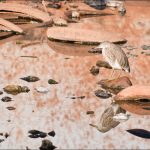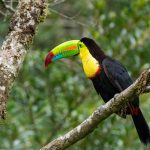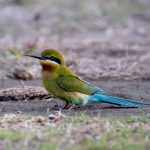Scientists have published their explanation for why some large species of bird, like the Lammergeier, have a silvery sheen in their wings. The scientists, led by Dr. Ismael Galvan of the National Museum of Natural Sciences in Madrid, had suspected that there was a difference in how the feathers were put together rather than a difference in pigment, and, sure enough, major differences in the barbules of the feather were found (barbules grow from the barbs, which grow from the shaft of the feather, the rachis, and barbules link together with each other and pretty much make a feather a feather). The differences in the barbules are described here.
Recent Posts
 The Bully in my BackyardBy a Guest
The Bully in my BackyardBy a Guest Ask A Bird Guide: What Conservation Challenge Most Directly Affects Birds In Your Region?By Editor
Ask A Bird Guide: What Conservation Challenge Most Directly Affects Birds In Your Region?By Editor Book Review – Amazing Hummingbirds You Can Find in ArizonaBy Leslie Kinrys
Book Review – Amazing Hummingbirds You Can Find in ArizonaBy Leslie Kinrys I Am We: A KidLit Bird Book ReviewBy Susan Wroble
I Am We: A KidLit Bird Book ReviewBy Susan Wroble Mountain Birds Running Out of SkyBy a Guest
Mountain Birds Running Out of SkyBy a Guest Bird Guides of the World: Quy, VietnamBy Editor
Bird Guides of the World: Quy, VietnamBy Editor Birding Bali Barat, IndonesiaBy Kai Pflug
Birding Bali Barat, IndonesiaBy Kai Pflug
Posting Calendar
| DAY | WRITER(S) | SERIES |
|---|---|---|
| MON | Kai (w) | Birding Lodges (w) |
| TUE | Donna (m) Susan (m) Hannah (m) Fitzroy (m) | Bird Guides (w) |
| WED | Leslie (bw) Faraaz (bw) | Ask a Birder (w) |
| THU | Paul (w) | Birder’s Lists (w) |
| FRI | David (w) | Species Spotlight (w) |
| SAT | Peter (bw) Luca (bw) | From the Archives (w) |
| SUN | Clive (w) | Three Photos (w) |
| w weekly, bw biweekly, m monthly | ||
| Any time: Jason, Mark, John, Sara, Rolf, Dragan | ||
See here for info on the writers.
Newsletter
Signup and receive notice of new posts!
Thank you!
You have successfully joined our subscriber list.












Amazing coincedence that this research should be in the news. I was photographing seabirds in the North Sea on saturday and have several images of Sooty Shearwater that appeared to show silvery secondaries at certain angles. This species would appear to fit the criteria indictaed by the research of ‘large dark plumaged open habitat species’. I have posted images on my blog and forwarded them to Dr Galvan in support of his team’s research.
Having sat alongside Alan on Saturday, and photographed the same birds, I agree that this could be similar to the sheen described by Dr Galvan and colleagues. However, in all of the Sooty Shearwater images this sheen occurs solely on the secondaries of the distal wing; the same bird flying left to right in the frame has silvery secondaries on the opposite wing to when flying right to left across the frame. Pale ‘silvery’ patches on the distal upperwing of flying seabirds have been described for other species previously. It may be due to the ‘sheen’ feathers described in the article but it is very angle specific. Two images of one bird, taken just a second apart(the first by Alan, the second by myself) show the sheen on one and clearly not on the other. The only difference between the images is the position of the wings. Searching for Lammergeier images on Google shows birds with both wings dark, or both wings silvery. The sample size of images from above showing both wings is rather limited though. Now there’s an excuse for a holiday if ever there was! And for spending more time photographing Sooty Shearwaters as well…
Nice research and I am sure the authors only picked that subject to be able to work on Bearded Vultures, the best birds ever!